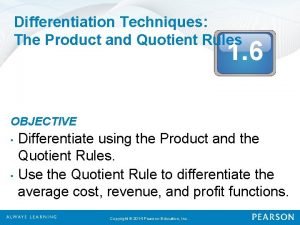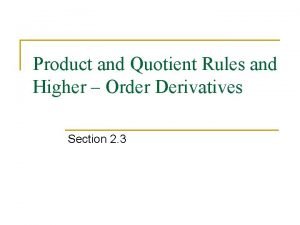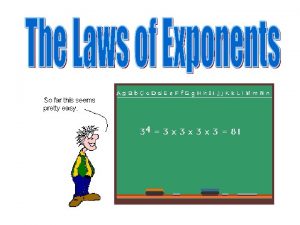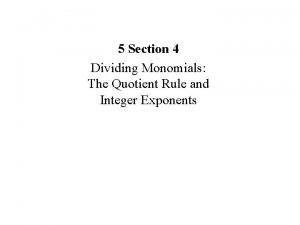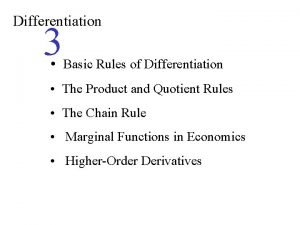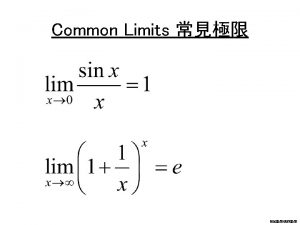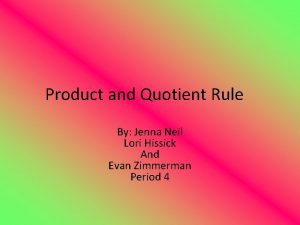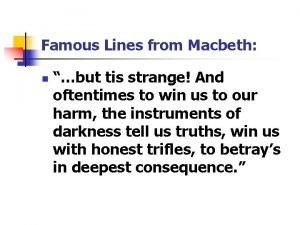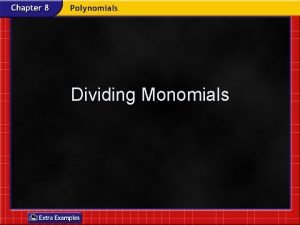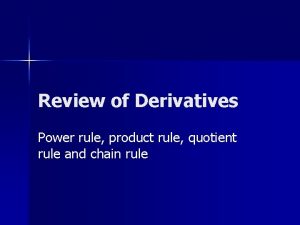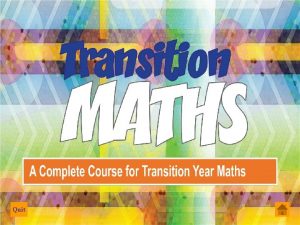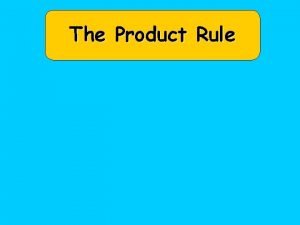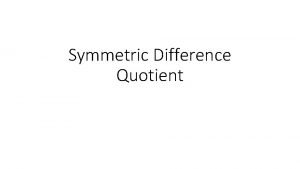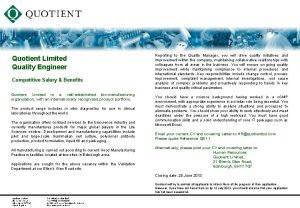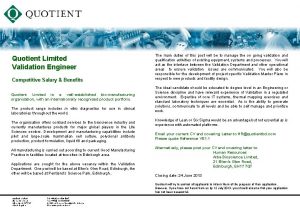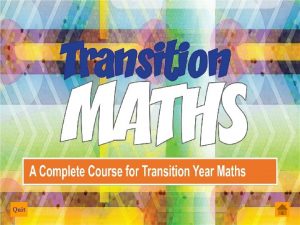Quit Introduction Definition Motion Product Rule Quotient Rule

















- Slides: 17

Quit

Introduction Definition Motion Product Rule Quotient Rule Quit

Introduction • Calculus is the ability to calculate the rate of change, known as the derivative, of one quantity with respect to another. • Sir Isaac Newton (1642– 1727) and Gottfried Leibnitz (1646– 1716) discovered calculus in the seventeenth century. It is one of the new branches of mathematics. Quit

Sir Isaac Newton • Newton is accepted as one of the greatest minds in the history of man. • He discovered much of the maths and physics we still use today. But he also spent time thinking about what happens after death and the possibility of eternal life. As a result he spent a large part of his life studying alchemy (a form of chemistry). Quit

George Berkeley • There is an Irish connection to the story of calculus. • One mile outside Thomastown in County Kilkenny on a bend of the River Nore is Dysart Castle and Church. • Bishop George Berkeley was born there in 1685. He opposed the new maths of calculus on the grounds that the small increments used were infinitely small. If they were zero, the whole grounds on which calculus is based is flawed. • Berkeley’s opposition to calculus is still valid but it is ignored because calculus is so useful. Quit

Definition dx _____ Change in x __ = dt Change in t Rule for simple Differentiation 1. Look at the number in front of the t 2. Multiply this number by the power of t Quit 3. Reduce the power of t by 1

Examples Multiply the power by the number in front and drop the power by one x = 5 t 2 dx = 5(2)t 1 dt = 10 t Quit x = 3 t dx =3 dt x = 5 t 2 + 3 t dx = 10 t + 3 dt

Examples Multiply the power by the number in front and drop the power by one x = 6 t 4 – 2 t 3 + 4 t 2 + 3 t – 2 dx = 6(4)t 3– 2(3)t 2 + 4(2)t 1 + 3 dt The differential of a constant is zero = 24 t 3 – 6 t 2 + 8 t + 3 Quit

Examples Multiply the power by the number in front and drop the power by one x = 6 t – 2 dx = 6(– 2)t – 3 dt = – 12 t – 3 Quit

Motion p q We will look at calculus from the point of view of the motion of a car moving to the right: x is the distance moved. Change in distance dx Velocity (v) is defined as the ________ = __ dt Time dv Change in velocity __ ________ Acceleration (a) is defined as the = dt Time Quit

Motion The manufacturers of a small rocket claim its motion is given by x = 3 t 2 + 2 t. Therefore the distance x it will move in metres can be found by putting the time t into the formula. After three seconds it will move 3(3)2 + 2(3) = 33 metres. Using calculus we can find its velocity or acceleration at any time t. Quit

Motion is defined by x = 3 t 2 + 2 t dx __ Velocity is defined by = 6 t + 2 dt dv __ Acceleration is defined by = 6 dt Quit

Product Rule dx dv du __ __ __ If x = uv then =u +v dt dt dt Quit

Differentiate (t 2 – 3)(2 – 3 t 3) with respect to t. u v Product Rule u = t 2 – 3 du = 2 t v = 2 – 3 t 3 dx = udv + vdu dt dv = – 9 t 2 dx 2 2 3 = (t – 3)(– 9 t ) + (2 – 3 t )(2 t) dt = – 9 t 4 + 27 t 2 + 4 t – 6 t 4 Quit = – 15 t 4 + 27 t 2 + 4 t

Quotient Rule du dv __ __ v – u u dx _____ dt dt __ __ If x = then = 2 v dt v Quit

2 t + 5 with respect to t. Differentiate _____ t 2 + 1 u = 2 t + 5 du = 2 2 t + 5 u x = _____ t 2 + 1 v dx vdu – udv = dt v 2 v = t 2 + 1 dv = 2 t Quotient Rule dx (t 2 + 1)(2) – (2 t + 5)(2 t) 2 t 2 + 2 – 4 t 2 – 10 t = = 2 2 dt (t + 1) (t 2 + 1)2 Quit – 2 t 2 – 10 t + 2 = (t 2 + 1)2

Do you want to end show? Yes No
 Product and quotient rule
Product and quotient rule Product and quotient
Product and quotient Product and quotient rules and higher order derivatives
Product and quotient rules and higher order derivatives Beduidende cijfers product en quotiënt
Beduidende cijfers product en quotiënt Derivative quotient rule
Derivative quotient rule Quotient rule of exponents
Quotient rule of exponents Quotient rule monomials
Quotient rule monomials The chain rule
The chain rule 希羅公式
希羅公式 Quotient rule hi di lo
Quotient rule hi di lo Quiz game
Quiz game The day the crayons quit summary
The day the crayons quit summary Quit ye like men
Quit ye like men Todd is trying to quit cheating
Todd is trying to quit cheating I can quit anytime
I can quit anytime Quit that shit
Quit that shit Who says but tis strange and oftentimes
Who says but tis strange and oftentimes Quit now maryland
Quit now maryland
